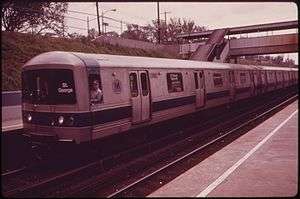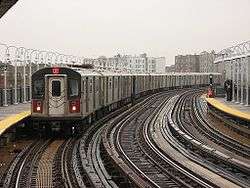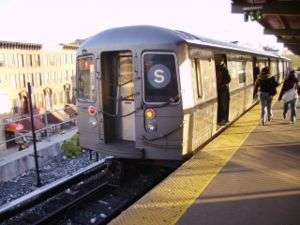R44 (New York City Subway car)
| R44 | |
|---|---|
|
Two R44 trains on the Staten Island Railway at Saint George Terminal. Notice the repainted bulkheads signifying the SMS process. | |
|
Interior of a Staten Island Railway-operated R44 car. | |
| In service |
1971–2010 (NYCTA cars) 1973-present (SIR cars) |
| Manufacturer | St. Louis Car Company |
| Built at | St. Louis, Missouri, USA |
| Replaced | Many R1-R9 cars, and all 1925 Standard Steel built SIRTOA ME-1 train cars. |
| Constructed | 1971–1973 |
| Refurbishment | July 1991 – January 1993 |
| Scrapped | 2012-2013 (All but 5 NYCTA cars, one damaged SIR car) |
| Number built | 352 |
| Number in service | 63 (SIR cars) |
| Number preserved | 1 |
| Number scrapped | 284 NYCTA cars and 1 SIR car (+4 NYCTA cars stored on property) |
| Formation | Single units (SIR), 4 car sets (NYCTA) |
| Fleet numbers |
5202–5479 (NYC Subway) 388–435, 436–466 (even) (SIRTOA) (cars originally numbered 100–435, 436–466 (even)) |
| Capacity |
A car: 72 (seated) B car: 76 (seated) |
| Operator(s) |
New York City Subway (1971-2010) Staten Island Railway (1973-present) |
| Depot(s) | SIRT (63 cars)[1] |
| Service(s) assigned | Staten Island Railway – 63 cars (15–16 trains) |
| Specifications | |
| Car body construction | Stainless steel with carbon steel chassis and underbody, with fiberglass end bonnets |
| Train length |
4 car train: 300 feet (91 m) 5 car train: 375 feet (114 m) |
| Car length | 75 ft (22.86 m) |
| Width | 10 ft (3,048 mm) |
| Height | 12.08 ft (3,682 mm) |
| Platform height | 3.76 ft (1.15 m) |
| Doors | 8 |
| Maximum speed |
Test: 87.75 mph (141.22 km/h) Service: 55 mph (89 km/h) - 60 mph (97 km/h) |
| Weight |
A train car: 88,950 lb (40,347 kg) B train car: 84,530 lb (38,342 kg) |
| Traction system |
NYC Subway: Westinghouse E-CAM XCA448F propulsion with Westinghouse 1447F motors 115 hp (85.8 kW) on all axles Staten Island Railway: General Electric SCM-CAM 17KG192A1 propulsion with GE 1257E1 motors 115 hp (85.8 kW) on all axles |
| Prime mover(s) | electric motor |
| Electric system(s) | 600 V DC Third rail |
| Current collection method | Contact shoe |
| Braking system(s) |
NYC Subway: Westcode (dynamic and friction), WABCO tread brake unit Staten Island Railway: WABCO RT5C (dynamic and friction), WABCO tread brake unit |
| Headlight type | halogen light bulbs |
| Track gauge | 4 ft 8 1⁄2 in (1,435 mm) standard gauge |
The R44 is a New York City Subway car model built from 1971 to 1973 by the St. Louis Car Company in St. Louis, Missouri for the IND/BMT B Division and the Staten Island Railway. The cars replaced many R1-R9 series cars and all 1925 Standard Steel built SIRTOA ME-1 trains, providing Staten Island with a new fleet of railcars.
Description
A total of 352 R44 cars were ordered: 300 cars for the New York City Subway (numbered 100–399, with 278 of the cars cars later renumbered 5202–5479) and 52 cars for the Staten Island Railway (also known as ME-2 or MUE-2 cars, numbered 400–435 and even numbers between 436–466).
The R44s originally came in singles, but needed each other to run, much like the "married pairs" of the R26/27/28/30s. The NYCT cars were reassembled after overhaul into ABBA sets of four; A cars are evenly numbered with operator cabs while B cars have odd numbers and no cabs. The SIR cars remain set up as singles.
Firsts
The R44 was the first 75-foot (23 m) car for the New York City Subway. The cars were introduced under the idea that a train of eight 75-foot (22.86 m) cars would be more efficient than one of ten 60-foot (18.29 m) cars. Despite the increase in length, the R44s had eight pairs of doors per car (four on each side) like other B Division cars. As a result, eight 75-foot (22.86 m) cars have only 64 (32 per side) pairs whereas ten cars have 80 (40 per side). The reduced number of doors on a train of eight 75-foot cars increased boarding and dwelling times, so recent car orders have returned to ten 60-foot (18.29 m) cars, starting with the R143. Due to their 75-foot length, the R44s were nicknamed "the hippos," along with the R46, R68 and R68A.
The interior design was very different from previous models. The R44s had orange and yellow plastic bucket seats, a feature which would be incorporated into the other 75-foot B-division cars and the A-division R62s & R62As. The seats were protected from the doorways by faux wood and glass panels. The walls were tan with "wallpaper" featuring the seals of New York State and New York City. This design continued onto the subsequent R46 cars.
The R44 was the first car since the BMT Green Hornet to incorporate a two-note warning tone, the first two notes of Westminster Quarters, that sounds before the doors begin to close as the car prepares to leave the station. When the cars were built, the chime was sounded four seconds before the doors closed, but the time delay was later removed.[2] This has become the signature sound of the subway and is used with all subsequent cars.[3]
The R44s also set the world speed record for a car. On January 31, 1972, a consist reached a speed of 87.75 mph (141.22 km/h) on the Long Island Rail Road's main line between Woodside and Jamaica. With two motors per car disabled, the car still reached 77 mph (124 km/h). The cars were capable of attaining even higher speeds, but the length of the test track was insufficient to allow further acceleration.[4][5] The R44s were built to reach such high speeds because it was anticipated that the cars would run along the Second Avenue Subway.
History
Pre-introduction
To ensure the subway could accommodate 75-foot (22.86 m) cars, two retired R1 cars (numbered 165 and 192; renumbered XC675 and XC575 respectively) were cut in half, lengthened to 75 feet (22.86 m) and sent to various places around the subway and the Staten Island Railway.[6]
It was determined that the BMT Eastern Division (the J/Z, L and M) would be too difficult to convert to allow 75-foot (22.86 m) cars to operate safely, so the R44s were not delivered to those lines.
Delivery and early mishaps

After many months of exhaustive testing on the A, D, E, and F (one week on each service, starting December 16, 1971), (as well as on the LIRR's trackage, as the R44s were new transit cars electrically and mechanically), the first sets of R44s was placed in service on the New York City Subway on the F in April 19, 1972, following a brief introductory ceremony attended by the Mayor of New York City John V. Lindsay, along with MTA Chairman William J. Ronan at the Jamaica – 179th Street station. The Staten Island R44s were delivered between January and April 1973.[4] The first six Staten Island R44s went into service on February 28, 1973.[5][7] With the completion of the R44 order, the St. Louis Car Company (established 1887), shut down operations.
388–399 were eventually sent to the Staten Island Railway.
Ten NYCT R44s were involved in various accidents and fires that led to their premature retirements before the General Overhaul Program (GOH) program for the R44s commenced, so they were not rebuilt during the GOH program. They were stored on the system until March 2001, when they were shipped off property and scrapped.[8][9]
General Overhaul Program, later mishaps, and recent work

During the General Overhaul Program, from 1991 to 1993, the remaining R44s were rebuilt by the NYCTA either at the 207th Street Yard in Manhattan or the Coney Island Complex in Brooklyn (cars 5342-5479 and all SIR cars) or by Morrison-Knudsen off NYCT premises (cars 5202-5341). Some improvements included the repainting of the carbon steel blue stripes into silver gray stripes, although NYCTA cars 5228-5229 and all SIR cars had their carbon steel sections replaced with stainless steel panels. The rollsigns on the sides were replaced with electronic LCD signs on the NYCTA cars and were completely removed on the SIR cars. The SIR R44s, however, retained their original two-note warning tone unlike the NYCTA R44s, which had their warning tones replaced with ones found in the R62/As and R68/As.
Despite the GOH, several NYCT R44s were retired due to various mishaps. Car 5248 was taken out of service in 2004 due to severe frame deterioration, and cars 5319 and 5402 were involved in separate fire-related incidents that led to car 5319 being scrapped and car 5402 being put out of service. Cars 5282-5285 were involved in a derailment that destroyed 5282 entirely, resulting in the rest of the set being placed out of service;[10] however, 5284 was later repaired using parts from other cars and returned to service until retiring along with the other NYCT R44 cars. This left 5248, 5283, 5285 and 5402 all stored out of service for parts until they were scrapped in 2013 with the rest of the fleet.
All SIR cars were overhauled for a second time between 2007 and 2010 as a part of the SMS (Scheduled Maintenance System) program. Several improvements included the repainting of the bulkheads, rebuilt trucks, new dark floors, new periwinkle bucket seats, and updated logos (unlike the NYCTA R44s, the SIR R44s' original blue "M" MTA decals were not replaced in the mid-1990s).[4]
Retirement
The MTA was planning to replace all the R44s with R179s.[11] However, in light of structural integrity issues found on the NYCT R44s (due to much higher levels of wear and tear, along with heavier level of mileage and vandalism than the SIR's R44s), surveys were conducted in 2009 on eight cars which resulted in the decision to retire them in place of the remaining R32s and R42s that were retiring at the time. As a result, the option order of R160 cars ended up replacing the R44s. The first cars were retired in December 2009 with the eight cars that failed the structural integrity tests, and the last train (cars 5378-5381 and 5426-5429) made its final trip on September 18, 2010 on the A and C. After retirement, NYCT cars (excluding cars lost in accidents) were mothballed and placed into storage system-wide (namely at the 207th Street, Pitkin, Concourse, and Coney Island yards).[12]
Starting in May 2012 and lasting until summer 2013, most of the NYCT R44s were scrapped at Sims Metal Management.[13][14] The five NYCT cars that were not scrapped are car 5240 (originally 172), which has been preserved by the New York Transit Museum, and cars 5286-5289, currently stored at the Coney Island Yard, although 5286-5289 are in poor condition and will be disposed of soon.
The Metropolitan Transportation Authority later dropped the plan to order R179s for the Staten Island Railway, instead opting to overhaul some R46s to replace the existing R44s there. However, the plan to overhaul the R46s for the Staten Island Railway was also dropped, and 75 R211S cars are planned to replace the Staten Island Railway's fleet of R44s instead.[15][16] The R44s are currently scheduled to be replaced in 2022–2023.[17] Out of the 64 SIR cars, car 402 was pulled from service after being damaged in a derailment at Tottenville in 2008, and was stored at the 207th Street Yard until 2013, when it was scrapped with most of the NYCT R44s.[18] Meanwhile, car 458, which also received damage from a derailment at the same location and station, was stored out of service until it was repaired in March 2016 at the NYCTA's 207th Street Yard Overhaul Shops using parts salvaged from retired NYCT R44s, then returned to service.[19]
See also
- R46 (New York City Subway car) - a similar model built by Pullman Standard.
References
- ↑ New York Subway Barn Assignments – November 6, 2016
- ↑ Davis, Ed, Sr. (June 1985). "Chapter 10, The Space Age on Rails". They Moved the Millions. Livingston Enterprises. Section A: A New Breed; the R44. ISBN 978-9996650697. Retrieved April 8, 2015.
- ↑ "Audible Information Design in the New York City Subway System: A Case Study" (PDF). Retrieved January 30, 2015.
- 1 2 3 "R-44 (St. Louis, 1971-1973)". www.nycsubway.org. 1995–2012. Retrieved April 5, 2015.
- 1 2 "New York City Transit Facts & Figures: 1979" (PDF). La Guardia and Wagner Archives. Metropolitan Transportation Authority, New York City Transit Authority. 1979. Retrieved 24 October 2016.
- ↑ Car XC675 (ex-165):
- Testagrose, Joe (September 1970). Car XC675 (ex-165) at Coney Island Yard. www.nycsubway.org (Photograph). Retrieved April 5, 2015.
- Hoskins, Steve (August 1976). Car XC675 (ex-165) at Coney Island Yard. www.nycsubway.org (Photograph). Retrieved April 5, 2015.
- Grotjahn, Doug (June 1, 1970). Car XC575 (ex-192) at Tottenville on SIRT. www.nycsubway.org (Photograph). Retrieved April 6, 2015.
- Testagrose, Joe (June 7, 1970). Car XC575 (ex-192) at St. George on SIRT. www.nycsubway.org (Photograph). Retrieved April 6, 2015.
- Grotjahn, Doug (September 27, 1970). Car XC575 (ex-192) at Jefferson Avenue on SIRT. www.nycsubway.org (Photograph). Retrieved April 6, 2015.
- Grotjahn, Doug (September 27, 1970). Car XC575 (ex-192) at Jefferson Avenue on SIRT. www.nycsubway.org (Photograph). Retrieved April 6, 2015.
- ↑ 1968-1973, the ten-year program at the halfway mark. New York.
- ↑ spicker613 (March 19, 2001). Original Kodachrome Slide NYC Subway R-44 120/109 207 Yard Scrap March 19, 2001. Flickr (Photograph). Retrieved April 8, 2015.
- ↑ spicker613 (March 19, 2001). Original Kodachrome Slide NYC Subway R-44 248, R-62 1439 Barge March 19, 2001. Flickr (Photograph). Retrieved April 8, 2015.
- ↑ Barron, James (July 5, 1997). "Investigators Seek Clues to Explain Subway Train Derailment". The New York Times. Retrieved April 8, 2015.
- ↑ "MTA Capital Program 2008–2013" (PDF). Metropolitan Transportation Authority. February 2008. p. 28. Retrieved April 8, 2015.
- ↑ Dooley, John (August 26, 2011). R-44 Car 5286 Pending Scrap. www.nycsubway.org (Photograph). Retrieved April 8, 2015.
- ↑ Noel, Nicholas (January 28, 2013). R-44 Car 5332 on Tractor Trailer. www.nycsubway.org (Photograph). Retrieved April 8, 2015.
- ↑ "R-44 (St. Louis, 1971-1973): Detailed Roster (Renumbering/Disposition)". www.nycsubway.org. 1995–2012. Retrieved April 8, 2015.
- ↑ "R34211 NOTICE -OF- ADDENDUM ADDENDUM #3" (PDF). mta.info. Metropolitan Transportation Authority. August 11, 2016. Retrieved August 15, 2016.
- ↑ MTA CAPITAL PROGRAM MILESTONES - March 31, 2011
- ↑ "MTA 2017 Final Proposed Budget November Financial Plan 2017 – 2020 Volume 2 November 2016" (PDF). mta.info. Metropolitan Transportation Authority. November 16, 2016. Retrieved November 17, 2016.
- ↑ Dooley, John (November 29, 2011). R-44 at 207th Street Yard. www.nycsubway.org (Photograph). Retrieved October 3, 2015.
- ↑ Stepansky, Joe (May 29, 2014). "2 workers injured, 1 car derails in Staten Island Railway accident". New York Daily News. Retrieved October 14, 2015.
Further reading
- Sansone, Gene. Evolution of New York City subways: An illustrated history of New York City's transit cars, 1867-1997. New York Transit Museum Press, New York, 1997 ISBN 978-0-9637492-8-4
External links
| Wikimedia Commons has media related to R44 (New York City Subway car). |
- New York City Subway Car Fleet June 2010 through November 2016
- Staten Island Railway
- nycsubway.org - SIRT Staten Island Rapid Transit
- nycsubway.org - NYC Subway Cars: R44



